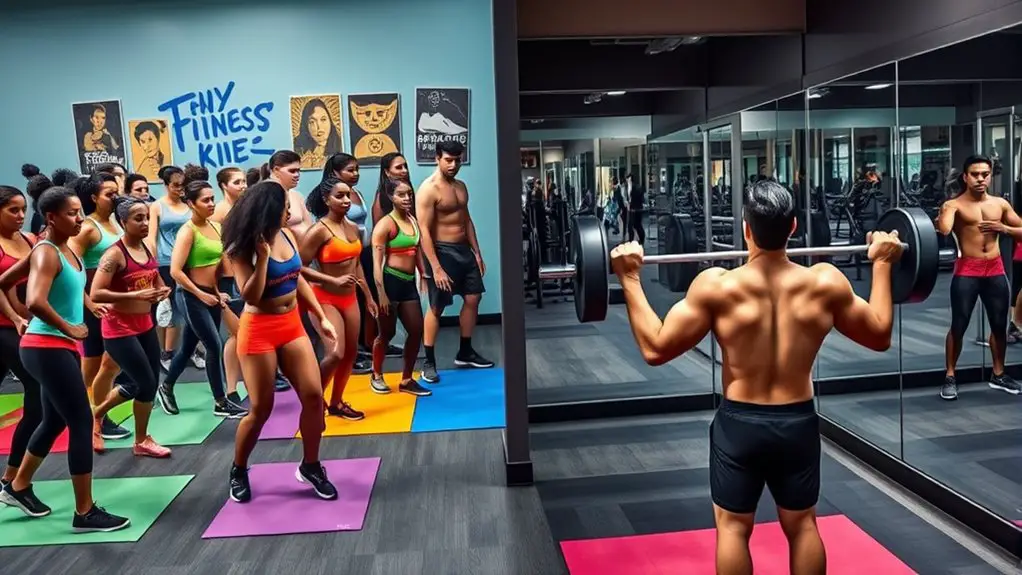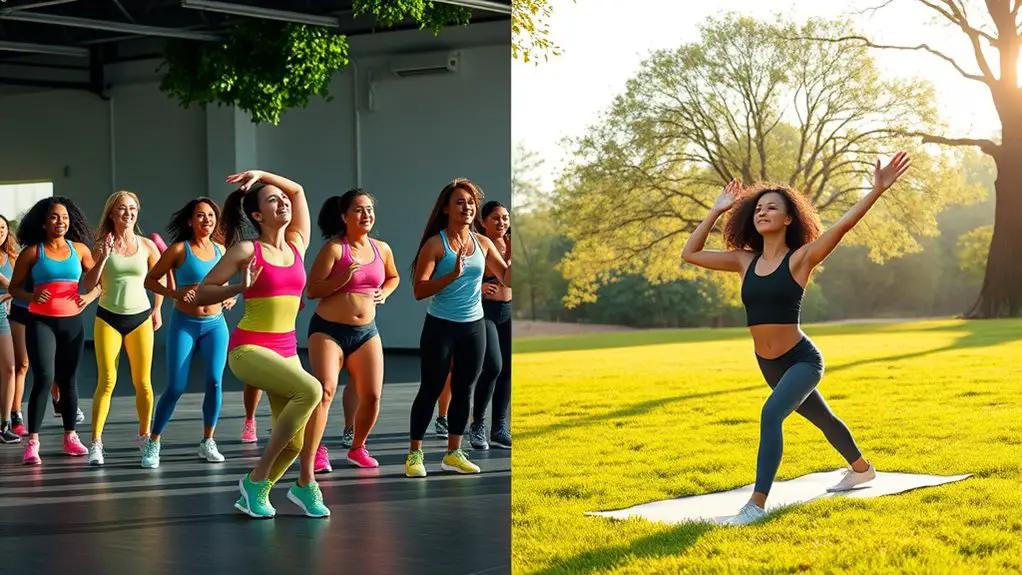Group Fitness Classes vs. Solo Training: Which Is Better?

When deciding between group fitness classes and solo training, consider what motivates you. Group classes create a supportive community that boosts motivation and offers accountability. In contrast, solo training lets you customize workouts to fit your personal goals and schedule. It also allows for flexibility in timing and pacing. Think about your preferences for social interaction versus independence, and how each option aligns with your fitness journey. There’s plenty more to explore about finding the right fit for you.
The Benefits of Group Fitness Classes

When you join a group fitness class, not only do you get a structured workout, but you also tap into a sense of community that can motivate you to push harder. The energy in the room is contagious, providing a motivation boost that keeps you engaged and focused. Plus, having others around you can create a supportive atmosphere, making it easier to stick with your routine.
In a group setting, you’ll find accountability partners who encourage you to show up and give your best effort. Knowing that others are counting on you can enhance your commitment to your fitness goals. Additionally, skilled instructors prioritize safety, ensuring that you’re performing exercises correctly and minimizing the risk of injury. This supportive environment helps you feel secure while challenging yourself. Ultimately, group fitness classes foster camaraderie and accountability, making your fitness journey not just safer, but more enjoyable.
The Advantages of Solo Training
While group fitness classes offer a vibrant atmosphere, solo training has its own set of distinct advantages that can cater to individual preferences and goals. One key benefit is the ability to create tailored routines that align perfectly with your fitness objectives and current skill level. This personalized approach helps you focus on what matters most to you, whether it’s strength training, flexibility, or cardio.
Solo training also fosters self-discipline development. When you work out alone, you learn to hold yourself accountable, which can enhance your commitment to achieving your goals. Plus, you can choose the time and pace that suit you best, minimizing the risk of injury while ensuring a comfortable environment. You can also experiment with different exercises without the pressure of others watching. In short, solo training empowers you to take charge of your fitness journey safely and effectively. Incorporating activities like skipping can improve cardiovascular fitness and enhance your overall workout routine.
The Social Aspect of Group Workouts

Solo training offers many benefits, but it can sometimes feel isolating. In contrast, group workouts provide a vibrant social atmosphere that can enhance your fitness journey. Here are a few reasons why the social aspect of group workouts is beneficial:
Group workouts foster a lively social environment that can make your fitness journey more enjoyable and less isolating.
- Team Motivation: Working out with others can push you to achieve more than you might on your own.
- Shared Energy: The collective enthusiasm in a class can elevate your mood and help you power through tough sessions.
- Supportive Community: You’ll find encouragement and camaraderie, making it easier to stick to your routine.
- Safety in Numbers: Exercising in a group can provide a sense of security, especially when trying new exercises or equipment.
Whether you’re a beginner or experienced, the social benefits of group workouts can make fitness feel less intimidating and more enjoyable. So, why not give it a try? You might just love the energy!
Flexibility and Personalization in Solo Training
If you prefer a workout routine tailored to your specific needs, solo training offers unmatched flexibility and personalization. You can create customized routines that align with your fitness goals, whether you’re focusing on strength, endurance, or flexibility. This level of customization guarantees that every exercise suits your body’s unique requirements, helping you stay safe and avoid injury.
Moreover, you can adjust your individualized pacing based on how you’re feeling that day. If you’re energized, you might push yourself a little harder; if you’re fatigued, you can take it easy without the pressure of keeping up with a group. This adaptability allows you to listen to your body and make real-time decisions about your workout intensity.
Ultimately, solo training empowers you to craft a fitness journey that’s as unique as you are, prioritizing both effectiveness and safety.
Which Option Fits Your Lifestyle Better?

How do you determine which workout option aligns best with your daily routine? Your lifestyle preferences and time constraints play a significant role in this decision. Consider these factors:
- Schedule: Do you have a fixed time for classes, or can you fit in workouts whenever it suits you?
- Social Interaction: Do you thrive in a group setting, or do you prefer the solitude of solo training?
- Motivation: Do you find it easier to stay motivated in a class with others, or can you push yourself during solo sessions?
- Safety: Are you comfortable with exercises that require supervision, or do you have the knowledge to train safely on your own?
Frequently Asked Questions
Are Group Fitness Classes More Expensive Than Solo Training Options?
When considering whether group fitness classes are more expensive than solo training options, it’s important to look at the cost comparison. Group classes often have a set fee, while solo training can vary widely based on personal trainers or gym memberships. You’ll want to factor in your budget considerations as well. Remember, investing in your safety and comfort is essential, so choose what aligns best with your financial and fitness goals.
How Do I Choose the Right Group Class for My Fitness Level?
Don’t worry if you think you might not keep up; most group classes are designed for all fitness levels. Start by identifying your fitness goals, then look for class formats that align with them. Consider options like low-impact classes if you’re concerned about safety. It’s also helpful to read reviews or ask instructors about their classes to guarantee you find one that matches your abilities and helps you progress confidently.
Can I Switch Between Group Classes and Solo Training?
Absolutely, you can switch between group classes and solo training! This flexibility benefits your routine and keeps your workouts fresh. Listen to your body and consider your training preferences; if you’re feeling social, join a class, but if you want to focus on specific goals, solo training might be better. Just guarantee you prioritize safety, whether you’re in a group or on your own, to avoid injuries and maximize your results.
What Should I Wear to a Group Fitness Class?
When choosing what to wear to a group fitness class, comfort and safety are key. Opt for appropriate attire that allows for movement, like moisture-wicking fabrics. Make sure your footwear choices include supportive sneakers that fit well, as this helps prevent injuries during workouts. Don’t forget about layering; a light jacket can be handy if the studio gets chilly. Prioritize your comfort, and you’ll enjoy your class much more!
How Do I Stay Motivated in Solo Training Sessions?
Staying motivated in solo training sessions can be challenging, but setting clear goals is essential. Break your goals into smaller, achievable milestones to keep things exciting. Consider finding accountability partners, whether friends or online communities, to share your progress. They can help keep you on track and provide support when you’re feeling unmotivated. Remember to prioritize safety by ensuring you’re using proper techniques and listening to your body throughout your workouts.





